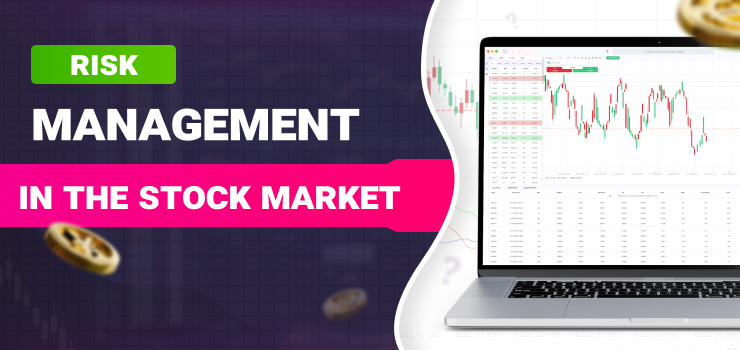The stock market has always been known for its many golden opportunities. Many traders have created wealth by trading stocks. However, the natural state of the stock market makes it filled with many underlying risks. Many factors, including political developments, business performance, investor sentiment, and economic conditions, all have an impact on the market. This article will help you understand these risks and show you how to avoid them or at least reduce any impacts that could occur with proper risk management.
Understanding Risk in the Stock Market
The stock market presents both opportunities and risks for investors. As with any potential investment, it is important to understand risk and how it can impact returns. This allows investors to make informed decisions aligned with their financial goals and risk tolerance.
Risk refers to the possibility that an investment’s actual return may differ from expectations. In the stock market, there are various types of risks that investors face. Market risk is due to overall stock market volatility that could cause portfolio prices to fluctuate. Company-specific risk relates to the possibility that an individual stock may perform worse than expected due to issues affecting that particular business. Systemic risk stems from events like recessions that impact the wider economy and financial system.
Investing in stocks carries risk by nature because it is impossible to foresee market movements exactly. Volatile times, like in recent months, can cause both actual and on-paper losses for portfolios if shares need to be sold at a discount. There is always a chance of small pullbacks and corrections, even in periods of growth.
Prudent risk management is essential to reaching financial objectives in the stock market. Investors may build diversified portfolios that are tailored to their risk tolerance by having a thorough understanding of the various risk factors.
Identifying and Assessing Risk
Before making stock investments, it is important for investors to carefully identify risks and ensure their portfolio is structured appropriately based on a thorough assessment of personal risk tolerance. Let’s explore the key steps in this process.
Extensive research is required to identify risks. By keeping an eye on key macroeconomic indicators and unemployment rates, you can identify economic dangers Industry hazards that require monitoring include changes in regulations. Examining balance sheets and earnings reports closely to identify any possible flaws is one way to identify company hazards. Speak with an advisor to identify potential hazards that may be hidden in public filings. Analyst projections and current P/E ratios are two examples of indicators that should be used to take into account the entire market conditions.
Risk-taking is necessary and each investor has a different capacity. With decades till retirement, growth-focused investors may want to consider high-risk techniques. Conservative investors who are close to or in retirement demand less risk since they have a lesser capacity for losses. An appropriate portfolio may be determined by using financial goals and questionnaires to assess tolerance. By doing this, investments are aligned and don’t result in regrets from taking on too much risk.
Risk profiling surveys are often used by advisers to identify goals and outline potential losses. Various asset allocations may be modeled to predict potential returns and losses over varying periods using interactive tools. Potential volatility is measured by maximum drawdown and standard deviation. When used in tandem, these resources enable careful risk budgeting that is tailored to the requirements and degree of uncertainty comfort of each investor.
Strategies for Managing Risk
Investors can help limit the risks associated with a stock market investment in several ways. Understanding diverse tactics enables the development of a customized risk-reduction strategy.
Investing across several asset classes, industries, and securities as opposed to focusing on a small number of them lowers risk through diversification. Purchasing protective puts or taking other offsetting trades helps reduce possible losses through hedging. Stop-loss orders cause assets to automatically be sold if they fall below a certain level.
Because diversification doesn’t depend on any one position, it offers stability. Returns, nevertheless, might not match a targeted approach. Although hedging premiums increase expenses, they might result in profits. Stop-losses reduce the potential for loss but increase the danger of selling too soon or missing further rallies.
Correlation can be decreased, for instance, by allocating 60% of a portfolio to foreign equities, 15% to bonds, and 25% to large- and small-cap stocks. To protect a stake in technology stocks, an investor might purchase put options. Stop-losses at 7% losses shield total returns from being harmed by holdings.
What is Hedging?
By having opposing positions, hedging can assist in lowering risk. By executing trades that profit from unfavorable price movements, hedging lowers the total risk of a portfolio. Purchasing options, for instance, protect a long stock position from downside risk. Futures contracts swap current cash for exposure to future events. Purchase/sell rights with set premiums are provided via options. Swaps are private agreements to swap cash flows in response to changes in interest and/or currency prices.
Hedging offers a layer of protection. One way to mitigate the risks associated with a focused stock choice is to purchase S&P 500 index futures. As a bear market approaches, options might be used to protect technology stocks.
How To Use Stop-Loss Orders in Risk Management
Stop-losses function as automated sell triggers to assist in reducing losses. To stop future losses, stop-losses sell assets when prices hit a certain level. This protects against losses in the event of unfavorable movements.
A predetermined price sets off predefined pauses. The trigger price is adjusted by trailing stops as the market moves. At a percentage drop from the purchase price, percentage stops become active. For instance, a 10% fixed stop on an ETF reduces the chance of a decline, while a 5% trailing stop on a stock safeguards gains as they increase.
Conclusion | Risk Management in The Stock Market
Long-term success in the stock market depends on the use of personalized risk management techniques. This article covered the several risks that might arise while trading and how to manage them sensibly using techniques like diversification, hedging, and stop-losses. Continuous education makes it possible to adapt strategies in response to shifting market conditions. With this information, you will be able to recognize risks and take appropriate action to create strong, goal-aligned portfolios that incorporate risk.
If you’ve enjoyed this article and want to continue learning about stocks and how they work, check out this article about how to trade stocks.



